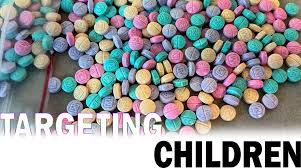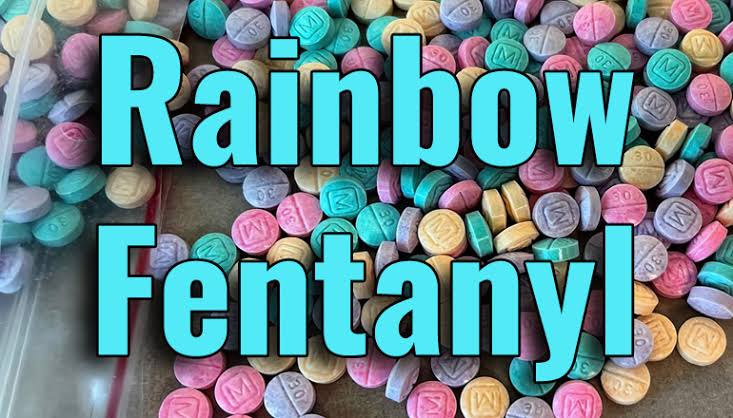Fentanyl: the Halloween scare about “Rainbow Fentanyl” a real one aimed at your kids?

Main highlights:
- Is rainbow fentanyl making its way to your kid’s bag?
- What makes us sure about the ill distribution of fentanyl in America?
On August 30 a warning was imposed by the Drug Enforcement Administration (DEA) It read, “Rainbow fentanyl—fentanyl tablets and powder that come in a variety of vivid colours, forms, and sizes—is a deliberate effort by drug traffickers to drive addiction amongst adolescents and young adults.”
Let’s examine “rainbow fentanyl” in more detail and examine all of the recent developments.
As “rainbow fentanyl” is not a recognised medical word, thus it is placed in quotation marks. Instead, it’s been used colloquially to refer to the potent synthetic opioid fentanyl that has recently started to appear in the headlines in multicoloured, perhaps candy-like forms. Here’s an excerpt from a recent CBS Los Angeles TV programme on a drug seizure by the Pasadena Police Department that netted over 300,000 fentanyl-laced pills:
In a video, bags were displayed and instructed to be filled with fentanyl-containing items. Evidently, discovering fentanyl that looks like sweets is not exactly uncommon. In 18 different states, the DEA and its law enforcement partners have already confiscated collections of “rainbow fentanyl,” according to a DEA release from August 30.
 Source: Google Images
Source: Google Images
Speaking of seizing, some politicians and political analysts have taken advantage of the DEA statement to raise even higher fears. For instance, on September 25, Senate Majority Leader Chuck Schumer (D-New York) said that Halloween was approaching and that the “rainbow fentanyl” situation was “really worrisome and really dangerous,” adding that “these drug traffickers are doubling down on their bet to hook young people.” Schumer then said that he would push for $290 million to be included in the federal budget “to fight the scourge of drug abuse.”
How worried should you be that “rainbow fentanyl” will somehow make its way into your kids’ bags?
Let’s start by taking a basic look at the fentanyl issue in the United States. Fentanyl is a potent illicit recreational drug that was first created as a potent treatment for patients with severe, intractable pain. It is about 100 times more potent than morphine and about 50 times more potent than heroin.
Fentanyl can injure your body in a number of ways, including impairing your capacity to breathe, in addition to becoming addicted. You’ve probably already noticed that breathing is somewhat necessary for the whole being alive thing. Fentanyl use in non-medical, non-prescription circumstances is extremely dangerous and has frequently resulted in death for this reason.
In reality, a record number of 107,622 drug poisoning and overdose deaths occurred in the United States in 2021, with synthetic opioids like fentanyl being to blame for about 66 per cent of them. Only two milligrammes of fentanyl are enough for it to be lethal. And getting that sum in the United States doesn’t seem to be all that difficult.
From May 23 to September 8, 2022, the DEA and its law enforcement partners recovered approximately 10.2 million fentanyl tablets and around 980 pounds of fentanyl powder, according to a DEA release from September 30. The One Pill Can Kill effort, so named because one pill of the substance may actually kill, was responsible for these convulsions.
What to take care of?
Given all of this, finding fentanyl that resembles candy is undoubtedly a bad thing. There is always a chance that if something resembles candy, kids will mistake it for something amusing and not harmful and put it in their mouths. Additionally, “rainbow fentanyl” refers to a wide range of vibrant substances, including pills, powders, and objects that resemble blocks of chalk.
Additionally, it doesn’t appear that these items’ risks are colour-coded in any specific way. Therefore, be aware that any form of fentanyl used outside of a legitimate medical environment is hazardous and perhaps fatal.
How much hard solid proof is there, though, that rainbow fentanyl is an intentional effort to hook American children addicted to fentanyl?
The possibilities:-
There are potential explanations for why such multicoloured forms of the synthetic opioid exist, Because trafficking fentanyl is different from trafficking a usual thing. It is prohibited to purchase and sell fentanyl for non-medical purposes. And individuals who engage in criminal activity frequently try to cover up their actions.
Another option is that fentanyl may be made more appealing to adults by changing colours. Yes, you can still enjoy colourful things even though you are old enough to handle your own finances, purchase ice cream whenever you please, and have existential dilemmas. Don’t thus assume that something that is colourful is doing so for children.
Thirdly, it’s possible that these fake fentanyl preparations are just manufactured that way by accident. According to Jorge Caballero, MD, a Clinical Instructor in Anesthesiology, Perioperative, and Pain Medicine at Stanford Medical School, even oxycodone formulations that have received FDA approval are available in a variety of candy-like hues.
 Source: Google Images
Source: Google Images
The non-possibilities:-
The candy-like appearance of rainbow fentanyl alone would be too much of a rainbow link to infer that there is a concerted, systematic effort to hook American children on fentanyl. It is not appropriate to assume intent only from appearance. It’s really unknown how many people are trying to impose fentanyl on children and younger adults, even if some are doing so.
Additionally, kids aren’t exactly known for having a lot of money on hand. Targeting children definitely wouldn’t be profitable for the majority of fentanyl sellers because being able to really pay for a product is typically a requirement that someone running a business wants to see in customers.
There are a number of alternatives that may be ruled out for this, but as of right now, there doesn’t seem to be any compelling cause to freak out and stop your kids from trick-or-treating this year or severely limit their customary Halloween activities.
The good option is to communicate openly with your children without frightening them or anybody else in the process, you can inform them about the wider fentanyl issue. You can certainly inform them of the existence of rainbow fentanyl. But raising your children to live in constant fear and distrust is probably not a good idea.
Instead, help them develop a general framework to better evaluate and avoid particularly risky situations in general. Make sure that your kids realize that just because something looks like candy doesn’t mean that it’s harmless.
Urge your kids to not consume anything that they can’t readily identify. Heed the U.S. Food and Drug Administration’s (FDA’s) standard advice to “tell children not to accept – and especially not to eat – anything that isn’t commercially wrapped.
Inspect commercially wrapped treats for signs of tampering, such as an unusual appearance or discoloration, tiny pinholes, or tears in wrappers. Throw away anything that looks suspicious.”








